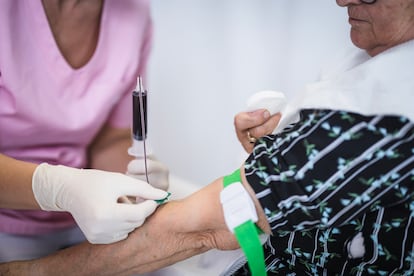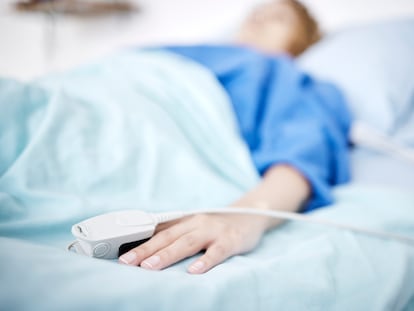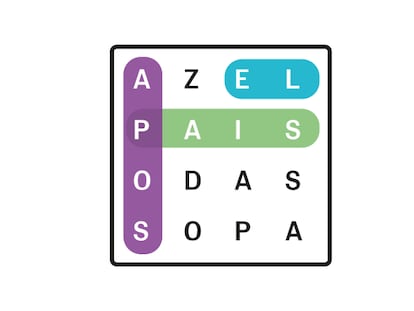New method detects Alzheimer’s in people with symptoms using a blood test
The system has an accuracy of over 90% and can be easily performed in a hospital laboratory

Detecting Alzheimer’s with a blood test is becoming easier. On Wednesday, the journal Nature Medicine published the work of an international team of scientists who tested the ability of the blood biomarker phospho-tau217 to predict Alzheimer’s risk in individuals with cognitive impairment. The study — led by researchers from the Barcelonaβeta Brain Research Center (BBRC), the Pasqual Maragall Foundation, and the Hospital del Mar Research Institute — analyzed 1,767 patients with symptoms of varying severity associated with Alzheimer’s. These subjects were recruited from hospitals and primary care centers in Spain, Sweden, and Italy. The test demonstrated an accuracy of over 90% in detecting the disease.
The discovery of biomarkers such as phospho-tau217 marked an important advancement in Alzheimer’s diagnosis. This particular form of the tau protein appears in elevated levels from the very early stages of the disease — sometimes even before symptoms occur — and is highly specific to Alzheimer’s. Until recently, detecting phospho-tau217 required a lumbar puncture to obtain cerebrospinal fluid, an invasive procedure. Alternatively, the amyloid PET scan, which detects beta-amyloid plaques in the brain associated with Alzheimer’s, is available, but it is more expensive.
In the past year, progress has been made in detecting the protein with blood tests. Although early analyses achieved high accuracy, they relied on technologies not widely available in standard laboratories. According to Marc Suárez-Calvet, a researcher at the BBRC and Hospital del Mar and a co-author of the study, the new method can now be performed “in almost any hospital laboratory,” and that makes “this biomarker finally something real for real patients.” In fact, since the study was conducted, many Spanish hospitals that were not part of the trial have already adopted the diagnostic method.
Despite its accuracy, Suárez-Calvet cautions that test results “must be interpreted by a specialist, following a comprehensive neurological assessment, and never used as a stand-alone test.”
Alzheimer’s is the most common form of dementia and the leading neurodegenerative disease, affecting approximately 800,000 people in Spain alone. Although emerging treatments show modest efficacy in slowing the progression of Alzheimer’s, tests are generally not performed on people who have not developed symptoms.
However, advancements in both prediction and treatment are fostering renewed optimism among experts. “Perhaps later, when treatments are available, we could consider performing screenings before the onset of symptoms, as is done with colon cancer,” says Suárez-Calvet.
This type of screening is complicated because the disease develops very slowly, and having early signs of the condition, such as amyloid buildup in the brain, does not mean it will develop. One-third of people over 65 have these plaques, and that does not mean they will develop Alzheimer’s.
The buildup of tau and amyloid proteins is considered a sign of Alzheimer’s disease, but it’s known that the problem begins much earlier. In trials with people with genetic Alzheimer’s — who are at much higher risk than the general population — diagnostic tests have shown that pathological changes can begin decades before the first symptoms appear.
The combination of early diagnosis and first-generation drugs capable of removing amyloid from the brain and modestly slowing the progression of the disease offers a glimmer of hope that Alzheimer’s specialists have not seen in years. One new drug is lecanemab. though the drug yields modest results and benefits only a small group of patients — who nonetheless continue to experience progressive degeneration — it has been viewed as a potential opportunity. Some studies even suggest the possibility of using lecanemab preventively in asymptomatic individuals with elevated biomarkers.
Sign up for our weekly newsletter to get more English-language news coverage from EL PAÍS USA Edition
Tu suscripción se está usando en otro dispositivo
¿Quieres añadir otro usuario a tu suscripción?
Si continúas leyendo en este dispositivo, no se podrá leer en el otro.
FlechaTu suscripción se está usando en otro dispositivo y solo puedes acceder a EL PAÍS desde un dispositivo a la vez.
Si quieres compartir tu cuenta, cambia tu suscripción a la modalidad Premium, así podrás añadir otro usuario. Cada uno accederá con su propia cuenta de email, lo que os permitirá personalizar vuestra experiencia en EL PAÍS.
¿Tienes una suscripción de empresa? Accede aquí para contratar más cuentas.
En el caso de no saber quién está usando tu cuenta, te recomendamos cambiar tu contraseña aquí.
Si decides continuar compartiendo tu cuenta, este mensaje se mostrará en tu dispositivo y en el de la otra persona que está usando tu cuenta de forma indefinida, afectando a tu experiencia de lectura. Puedes consultar aquí los términos y condiciones de la suscripción digital.
More information
Archived In
Últimas noticias
Half of Scotland is in the hands of 420 property owners
Pinochet’s victims grapple with José Antonio Kast’s rise in Chile
Reinhard Genzel, Nobel laureate in physics: ‘One-minute videos will never give you the truth’
From digital curfews to blocking apps: How technology experts protect their children online
Most viewed
- Pablo Escobar’s hippos: A serious environmental problem, 40 years on
- Reinhard Genzel, Nobel laureate in physics: ‘One-minute videos will never give you the truth’
- Why we lost the habit of sleeping in two segments and how that changed our sense of time
- Charles Dubouloz, mountaineering star, retires at 36 with a farewell tour inspired by Walter Bonatti
- The Florida Keys tourist paradise is besieged by immigration agents: ‘We’ve never seen anything like this’











































